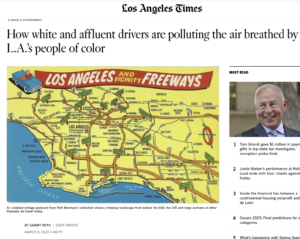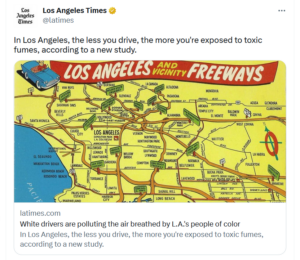
Like many Angelenos, I spend a lot of time behind the wheel of my car. I drive from my Westside apartment to Dodger Stadium near downtown and farther east to hike in the San Gabriel Mountains. I take the 405 Freeway north to the San Fernando Valley to see friends, or occasionally south to the L.A. Times office — or to the airport, where I grow my carbon footprint even further.
So I couldn’t help but consider my own complicity while reading a new study from USC researchers, finding that Angelenos who drive more tend to be exposed to less air pollution — and Angelenos who drive less tend to be exposed to more pollution.
My colleague Terry Castleman wrote about the study, which was published in the peer-reviewed journal Urban Studies. The core finding is that for every 1% increase in miles driven to and from work by people who live in a particular part of L.A. County, there’s an estimated 0.62% decrease in the lung-damaging “fine particulate matter” to which those Angelenos are exposed.
How is that possible? I asked the study’s lead author, Geoff Boeing, a professor at the USC Sol Price School of Public Policy.
He told me it largely comes down to the shameful history of Los Angeles County’s low-income communities of color being torn apart to make way for freeways — a history that has been extensively documented by The Times. Today, many residents of the county’s whiter, more affluent neighborhoods — who were often able to keep highways out of their own backyards — commute to work through lower-income Black and Latino neighborhoods bisected by the 10, 110 and 105 freeways and more.
“It’s not like commuters are coming in and shopping in those communities, patronizing restaurants,” Boeing said. “They’re just driving through to get from one side of the city to the other.”
Southern California has some of the nation’s worst air quality. Cars and trucks are one of the main reasons why — and the closer you are to the source, the more danger you face. Whenever I move, I insist on finding an apartment at least 1,000 feet away from the nearest freeway, after reading an L.A. Times investigation revealing that people who live near freeways suffer higher rates of asthma, heart attacks, strokes, lung cancer, pre-term births and potentially other illnesses, such as dementia.
Boeing has gone a step further, taking an air-quality monitor with him when he and his wife were looking for a new home a few years ago. He got one of his highest readings for particulate matter near the 101 Freeway in Echo Park.
“I have a small child. I try as hard as I can to avoid air pollution,” he said.
Boeing’s family moved to South Pasadena — the “ultimate suburban flight story,” as he put it, and a place with a “terrible racial history.” Residents of the relatively affluent, predominantly white city were able to block construction of the 710 Freeway through their neighborhoods. As a result, he told me, truck traffic from the ports of L.A. and Long Beach ends up routing through lower-income neighborhoods in Alhambra, a city whose population is overwhelmingly Asian and Latino.
Boeing is acutely aware that he and his wife and son are the beneficiaries.
“I absolutely love that there are no freeways anywhere near us,” he said
As a white guy who’s lived on L.A.’s Westside for most of my life, I’ve benefited from the region’s sordid history as well. \
…
Overall, though, the map shows how residents of whiter, wealthier communities disproportionately drive to work through lower-income Latino and Black neighborhoods, spewing pollution. Residents of those neighborhoods can’t do much about it.
“If you want to be exposed to less pollution, you can’t be the change you want to see in the world,” Boeing said. “It’s up to everybody else who is taking advantage of public infrastructure and releasing tailpipe emissions.”
Boeing was careful to note that the study doesn’t conclusively prove that patterns in how Angelenos get to work are solely responsible for different levels of air pollution in different communities. Majority-white Westside neighborhoods, for instance, could also be benefiting from ocean breezes that push pollution into predominantly Black and Latino areas, he said.
…




